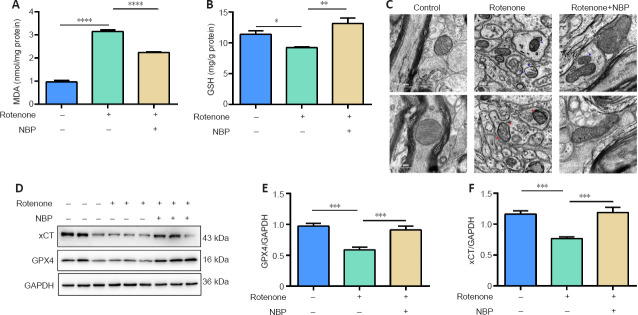Figure 5.
NBP reduces oxidative stress and mitochondrial damage and increases xCT and GPX4 expression in the substantia nigra in a rat model of Parkinson’s disease.
(A, B) MDA (A) and GSH (B) levels in the substantia nigra. (C) Mitochondria in the substantia nigra in the rat model of Parkinson’s disease with or without NBP treatment were examined using transmission electron microscopy. Mitochondria were intact in the control group; mitochondrial shrinkage was accompanied by increased membrane density and ruptured membrane density. Mitochondrial shrinkage was significantly improved and membrane rupture was alleviated after NBP treatment. Red arrows indicate destruction of the mitochondrial double membrane; blue arrows indicate destruction of the mitochondrial outer membrane. Scale bars: 500 nm. (D) Western blot analysis of the expression of xCT and GPX4 in the substantia nigra in the rotenone-induced rat model of Parkinson’s disease with or without NBP treatment. (E, F) Quantitative results of GPX4 (E) and xCT (F) expression. All data are shown as the mean ± SEM (n = 5–10 rats per group). *P < 0.05, **P < 0.01, ***P < 0.001, ****P < 0.0001 (one-way analysis of variance followed by Tukey’s post hoc test). GAPDH: Glyceraldehyde-3-phosphate dehydrogenase; GSH: glutathione; GPX4: GSH peroxidase 4; MDA: malondialdehyde; NBP: DL-3-n-butylphthalide; xCT: cystine/glutamate antiporter solute carrier family 7 member 11.

